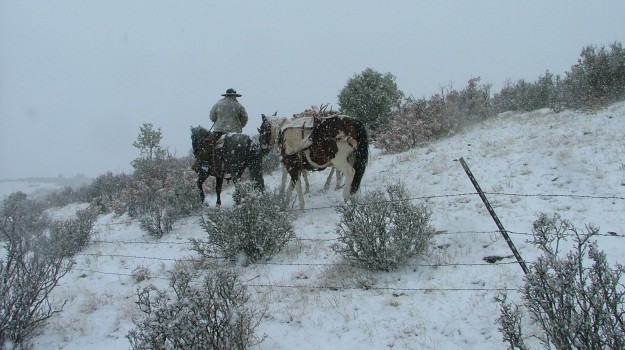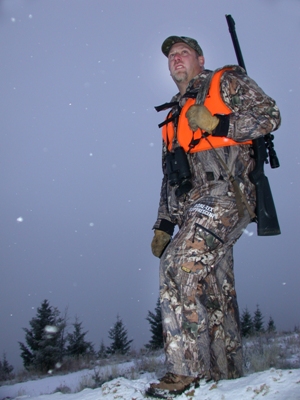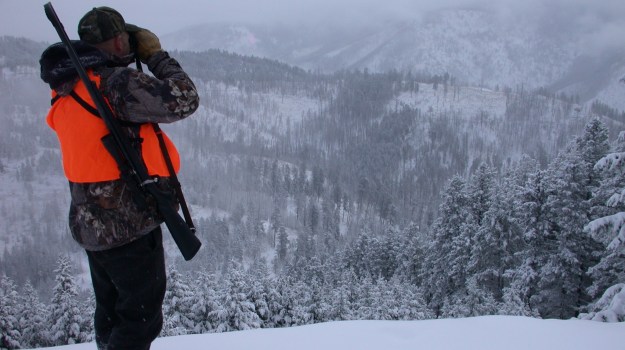
Unless you're hunting for meat, most people want to take the herd bull. He's usually the biggest and the smartest bull in the herd. As the elk come out of the high country and the national forests, you will see a lot of cows, satellite bulls and raghorn bulls all in the same group. Usually, these herds will be bunched up in tight groups. At this time of the year, the herd bull isn’t looking for a cow to breed, and the satellite bulls aren’t looking for a cow that’s wandered away from the herd. All the reasons that you can get a bull close to you in the early season are no longer factors.
In the late season, patience will be your number-one tactic if you're trying to take a herd bull. Often the herd bull will be covered up with cows. If you're bowhunting in the late season, taking a herd bull becomes much more difficult than if you're hunting with a rifle. Rifle hunters definitely have an advantage in the late season, because they can take a shot out to 100 yards or more. But for the rifle and the bow hunter, the real challenge is what’s behind the bull you're trying to shoot. Even if you have a bull standing broadside at 30, 50 or 100 or more yards and a cow or another bull is behind the bull you're trying to take, you can’t shoot, because the arrow or the bullet most likely will go all the way through the elk and hit the elk that’s standing behind the bull at which you’ve shot.
In the late season, I've seen herds of elk as small in number as only 12 elk and as large in number as 50 or more elk. When you have that many elk bunched up, walking through the woods, meadows or fields feeding, you have to be extremely careful of your shot placement. If you're hunting with a firearm, and you're close enough to take a shot, and you see a nice bull you want to take, you need to get settled in to your shooting sticks, get well braced against a tree or get your rifle snugged-down on your pack to have a very good shooting position. Once you’ve accomplished that feat, continue to tell yourself, “Don’t take the shot until I know what’s behind the bull I’m trying to take.”
 If you're hunting with a bow, you need to determine which way the elk are going. Try to move in close to the herd without them seeing, smelling or hearing you, and let the hunt unfold in front of you. Wait for that clear shot on the herd bull, which you may or may not be able to take. One of the big challenges for the bowhunter is that you not only have multiple targets, but you'll also have multiple backstops. With the speed of the bows today, it’s not uncommon at all to get a clean pass-through on either a double lung or a heart shot. So, you have to look through the elk you're trying to take and see what your arrow may hit, if you get a pass-through shot on a herd bull. You don’t want to put more than one elk on the ground.
If you're hunting with a bow, you need to determine which way the elk are going. Try to move in close to the herd without them seeing, smelling or hearing you, and let the hunt unfold in front of you. Wait for that clear shot on the herd bull, which you may or may not be able to take. One of the big challenges for the bowhunter is that you not only have multiple targets, but you'll also have multiple backstops. With the speed of the bows today, it’s not uncommon at all to get a clean pass-through on either a double lung or a heart shot. So, you have to look through the elk you're trying to take and see what your arrow may hit, if you get a pass-through shot on a herd bull. You don’t want to put more than one elk on the ground.
In the early season when bulls are looking for cows, and the cows and bulls are up moving a lot, you can find a good place to try and call a bull into you. Most of the time, you won’t have to worry about what’s behind the bull you're trying to take. However, in the late season, when the bulls are with the cows, what’s on the other side of the elk you want to shoot is as important, if not more important, than taking that herd bull.
In the early season, you can depend on your scouting and your calling to bring in the bull. In the late season, your woodsmanship is far more important than your scouting or calling, because once you locate the elk, they may not be there the next day. So, every time you pinpoint a herd of elk, if you spot the bull you want to take, the stalk and the hunt begins right then. The next day that herd may be a mile or more away.
In the early season, your best hunting usually will be early in the morning and late in the afternoon. But in the late season, the elk generally will be on their feet all day long, trying to find as much food as they can and eat as much as possible. In the early season, elk will usually bed down in the middle of the day, but in the late season, the elk will rarely bed down during the day. They stay on the move.






























